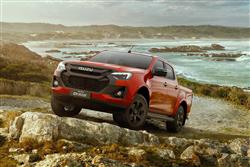Isuzu D-Max - ABC Leasing
D-LIGHT-FULL(some text hidden)
By Jonathan Crouch
Ten Second Review word count: 102
If you thought Isuzu pick-ups were a bit rough and ready, it's probably about time you gave the D-Max a try. Once, this brand was really one reserved for the requirements of pure commercial operators. In this rejuvenated 'RG'-series form though, the D-Max will also suit private buyers looking for an all-terrain utility vehicle that can play the lifestyle card, thanks to now-sharper looks, a smart cabin and solid drive dynamics. But it's still as tough as ever - which is why so many professionals choose this Isuzu. In a marketplace full of pretenders, it's that rarest of things: the genuine article.
Background word count: 147
Isuzu's D-Max is the pick-up truck you choose for value and tough build. The current RG-series design (co-designed with Mazda) has been around in the UK since 2021 (two years after it went on sale in other markets) and was treated to a light update in 2023, before getting the further update in early 2025 that we're going to look at here. These updates are timely because they arrive just as UK pick-ups start to be taxed as cars - a devastating blow for this segment. Isuzu's been doing well here, selling over 6,600 D-Max models here in 2024 (its most successful year ever). And the brand says that it expects to be less affected by the change of tax rules than brands who sell more lifestyle-orientated pick-ups. But just to make sure, there's this updated D-Max to keep this contender current. Let's take a closer look.
Driving Experience word count: 392
Here, we're focusing on Isuzu's now-familiar four cylinder turbo diesel powerplant, offering 162bhp and available with either manual or auto transmission. There's also now a 188bhp full-EV version, using a 66.9kWh battery that offers a range of 163 miles. The 1.9-litre diesel is a smaller capacity engine than you'll find with direct rivals and its 360Nm torque output is lower too, though a 3.5-tonne towing capacity is retained. This relatively light powertrain though, enables the kerb weight of this Isuzu to dip below the government's 2,040kg weight limit that separates Goods Vehicles from passenger cars so, unlike other pick-ups in the segment, this one can be driven at passenger car speed limits. The key driveability change as part of this update is the addition (above base trim) of a new 'Rough Terrain' drive mode. This works in conjunction with the traction control system and senses when a wheel doesn't have enough grip and is spinning faster than it should be when you're off road. The system then applies the brakes and throttle as necessary to get you moving. You're supposed to engage it before you get into a muddy situation - say at the base of a steep slippery hill. Progress through really gnarly stuff is aided by decent suspension articulation and the lockable rear differential you get on most models. Ground clearance is rated at 235mm and the fording depth at 800mm. As before, the 4WD system has capable low ratio gearing, an effective hill descent control system and a display showing what angle you're at. You can switch between two and four wheel drive on the move too, via a provided rotary dial. As for on-tarmac journeying, well the D-Max is better than it used to be in terms of cruising refinement, but it still lags behind rivals and is hardly car-like. No contender in this class can properly replicate the car-like drive dynamics of an SUV and in this one, there remains plenty of body roll at speed through tighter turns as you slide around on the flat-bottomed seats. But on the plus side, there's not too much back end floatiness when the load bay is empty and with a bit of weight in the back, it's possible at times to forget you're in a pick-up - until you lurch into a corner or clump over a speed hump.
Pictures (High res disabled)

.jpg)
.jpg)
.jpg)
.jpg)
.jpg)
.jpg)
.jpg)
Scoring
Category: Compact Car
| Performance | |
| Handling | |
| Comfort | |
| Space | |
| Styling | |
| Build | |
| Value | |
| Equipment | |
| Economy | 70% |
| Depreciation | 80% |
| Insurance | 70% |
| Total | 68% |